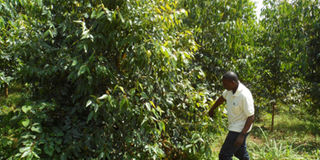Prime
Why engage in commercial tree planting in Uganda?

Commercial trees. File photo
What you need to know:
Private planters under the SPGS benefit from various ways, notably, site visits from the SPGS Technical Advisory team; plantation training courses; quarterly meetings to share experiences, and tree planting guidelines
Uganda is fast approaching a major shortage of sawn timber. To meet the increasing demand, the country will soon have to import timber as well as face increased pressure on its remaining tropical forests.
To counter both these scenarios, Uganda is now encouraging investment in timber plantations, through both the public sector, National Forest Authority (NFA), and the private sector.
Indeed, the private sector interest in timber plantations has taken off exponentially, spurred on since 2004 by the Sawlog Production Grant Scheme (SPGS) through the support of the European Union.
What is the current situation?
The 12,000 hectares (ha) planted in the late 1960s and early 1970s have been ‘mined’ over the last 10 years and have only started to be replanted since 2003.
It has been estimated that at least 75,000 ha of timber plantations are needed just to meet the projected internal timber demand by 2025.
Uganda has excellent conditions to support commercial tree growth. With good management and the adoption of intensive silvicultural practices, growth rates can match the best in the world and there is also a solid return on investment.
Is there land available?
There are substantial areas of land suitable for timber plantations, both public and private owned. Long-term leases for tree planting are available; the first licenses were issued by the NFA in mid-2005. Potential investors must realise that the areas are more suited to pines than Eucalypts, being in hotter, drier areas.
What are the main markets?
The main requirement in Uganda is for general purpose timber for construction and furniture making. Pine is suitable for these markets and could eventually replace much of the hardwood timber being used.
There is also a good market for veneer logs, which can be met from E. grandis Araucaria spp. There is also a good market for electricity poles (Eucalyptus spp.), which are currently being imported into Uganda. Near urban centres there is a good market for E. grandis building poles. Current recovery rates for timber from E. grandis are poor but it is expected that this will improve and E. grandis will become a major timber source within 10 years.
What does it cost to establish timber plantations?
We have estimated that, on average, it will cost around Shs1.5m per hectare (US$730) to establish a plantation. This cost covers all expected costs up to canopy closure (that is, when the tree canopies in adjacent rows touch and shade out the ground vegetation), which is around three years with Pinus caribaea, 1-2 years with E. grandis.
Costs will differ significantly on different sites and also depending on the supervision and level of skills of the labour. Other factors that can influence establishment costs are the scale of the planting, the level of mechanisation and the timing and frequency of key operations, especially weeding.
What returns can I expect?
A recent independent study carried out for the SPGS (by LTS International Ltd.) calculated real rates of return (RoR) of nine to 15 per cent. When adjusted for inflation at five to six per cent, these RoR approximate to 15 to 18 per cent financial RoR including inflation, which is favourable compared to plantation investment in many other countries.
The study also noted that the RoR depend on the costs of establishment, the productivity of the plantations, the conversion rate at sawmills and the import price of sawn timber.
How long do I have to wait?
This depends on the potential of the site (that is which species are suited to grow there) and also the objective(s) of the grower. Assuming the plantations have been properly managed using the intensive silvicultural techniques recommended by the SPGS, rotations for pine sawlogs of around 20 years are expected, compared to eight to 15 years for E. grandis.
For pines, the second and third (final) thinning will yield some sawlogs; for E. grandis, all thinnings will yield utilisable products. For both Pines and E. grandis, however, the major income only comes at final felling of the large sawlogs.
Are there any incentives to invest in timber plantations?
The main incentive for private growers is the planting grant provided under the SPGS, which covers half of the estimated establishment costs. Following the LTS study, the SPGS is coordinating efforts with the government to change the unfair fiscal treatment of forestry. The likely options being considered are: to allow the costs of replanting to be set against the proceeds from the harvest of the first crop; and exemption from income tax.
Private planters under the SPGS benefit from various ways, notably, site visits from the SPGS Technical Advisory team; plantation training courses; quarterly meetings to share experiences, and tree planting guidelines
Source: Sawlog Production Grant Scheme




